[Apple II, Abrams & Everson (aka Midkemia Press)]
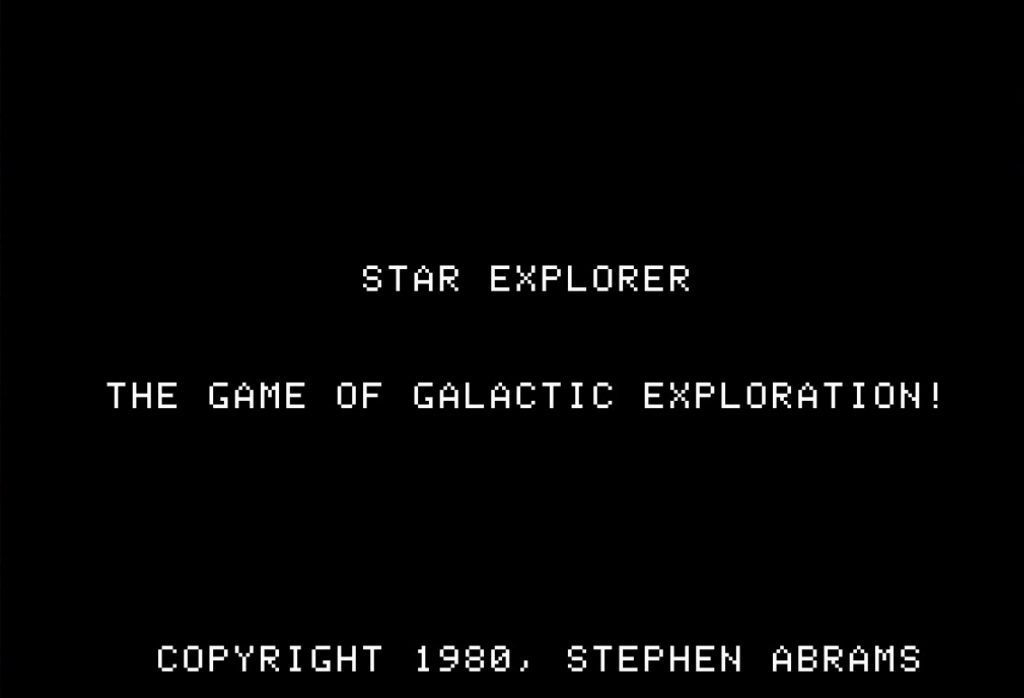
In August 2024, one of Renga-in-Blue’s commenters brought his attention to a data dump that included some of the games he was looking for. The “dump” turned out to be quite the treasure trove, as it included, in addition to two adventure games, several lost North Star Horizon wargames – all of them multiplayer, but they may still appear on this blog. Checking after me, commenter Porkbelly noticed a game whose value I did not know: the hitherto lost and highly sought-after Star Explorer. Star Explorer had been distributed confidentially in 1980 (fewer than 200 copies, possibly fewer than 100), and all hope of finding it had been lost. Today, I have the privilege of being the first in more than 40 years to review it.
Star Explorer is not a wargame but, well, a space exploration game – think early Star Trek, but without the episodes where Captain Kirk needs to find a traitor among the crew. After choosing if you want to do only one exploration run or a full campaign, you pick your ship:
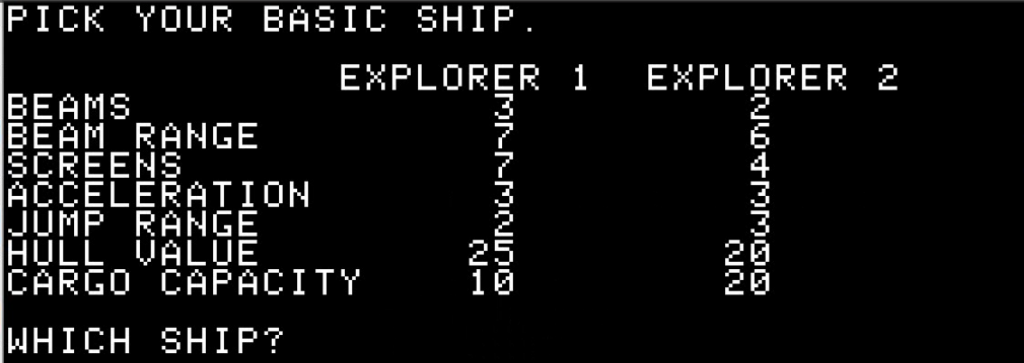
Explorer 1 is supposedly more combat-oriented with one extra laser beam and better screens [=shields]. However, it has way too little cargo capacity for my taste, and in my test I found out that boarding crews and missiles (which require cargo space) beat beams anytime, so in my opinion Explorer 2 is also better in combat, though less resilient (screen damage repairs, hull damage does not). I choose Explorer 2. While I can’t name her in the game, she is going to be the USS Constellation to me.
After choosing the ship, it is time to prepare her on a budget, as I have only 35 megacredits (megs):
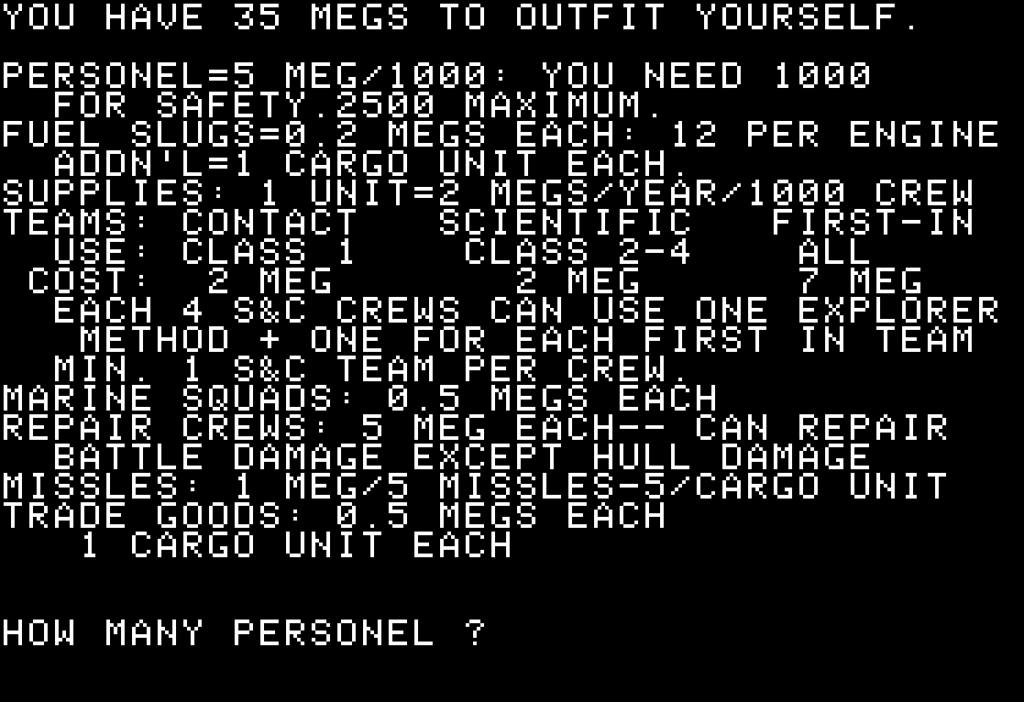
The different options are:
- Personel – Useful to steer the ship, critical for boarding action. I take 2000 of them. Cost: 10 megs,
- Fuel slugs – I never needed a lot in my test, so I take only 10. Cost: 2 megs,
- Supplies – Needed to feed the men. This one is expensive. I take 4. 1000 men consume 1 every year, so my expedition will last a maximum of 2 years. Cost: 8 megs
- Survey teams – Used to explore planets. There are three types of survey teams. “Contact” and “Scientific” deal with different classes of planets, “First-in” teams can cover all classes and have better survivability if things go awry. I take one of each, cost 11 megs.
- Marine squads – They help when things go awry on a planet. I already have First-in teams, so not needed.
- Repair crew – They can repair your ships during and after combat (except the hull), but they are relatively expensive. I feel it’s either the First-in team or the repair crew, and as above I went for the former
- Missiles – They’re like the photon torpedoes in Mayfield’s Star Trek: OP. I take 2×5 for 2 megs.
- Trade goods – To trade with natives in exchange for tobacco and gold, typically. I spend the rest of my megs to buy 4 of them. Cost: 2 megs.
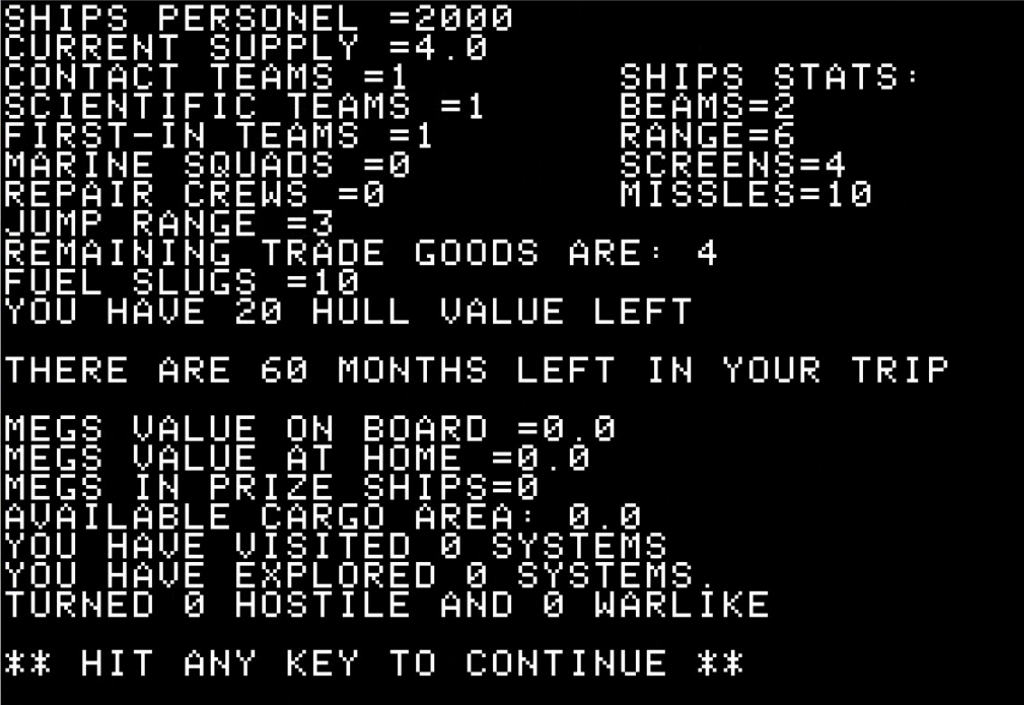
A. First mission – High space piracy
The Constellation starts in her home system in 8,6. For now, the rest of the galaxy is split between unexplored systems (NP for non-proven) and empty but dangerous clouds (C),
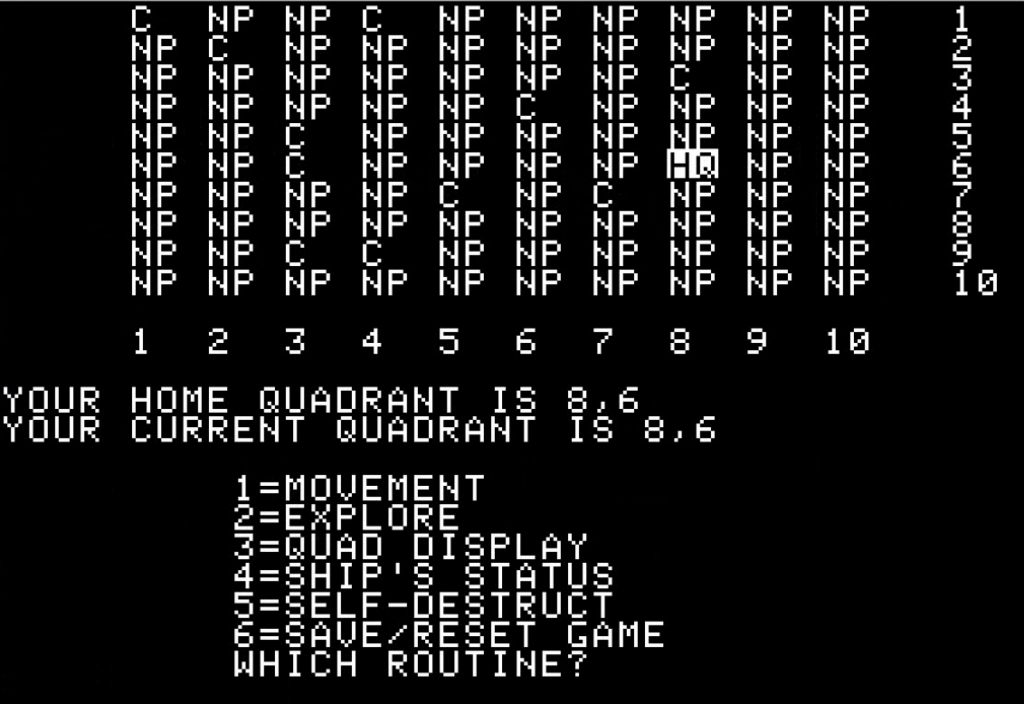
I jump to the system in 8,7. It contains 2 stars.

Each star contains exactly one valuable planet, and I need my survey teams to find it. However, this takes time and is not without risk. For each of my teams (in this case the contact team and the first-in team) I must choose a method of exploration. The higher-numbered methods are more likely to find something, but also more likely to be detected by pirates.
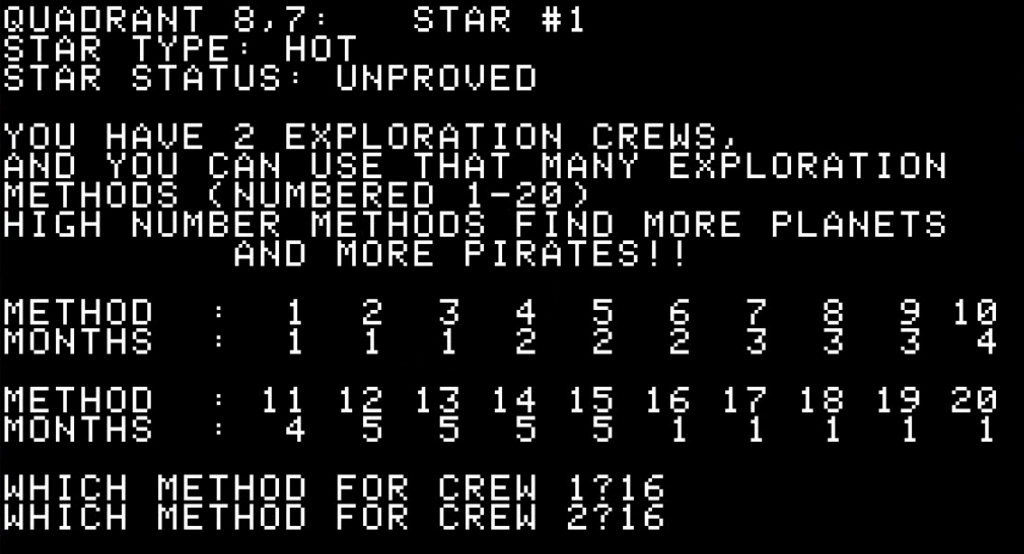
In this case, we find a planet inhabited by rodents. My attempts to show them Disney footage to prove that humans do love rodents fail, and after shooting Security Officer Thomas the blasted rats try to blackmail us…
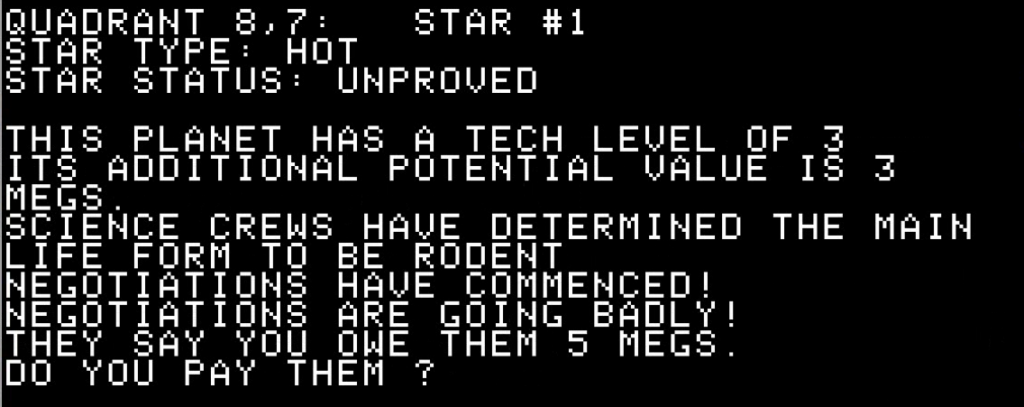
… which absolutely works, because those 5 megs will be paid when I return to Starbase. In the future, you can pay your extortion money with a revolving credit!
One star done, another to go. This time, my exploration is interrupted by space pirraaates! Arr!
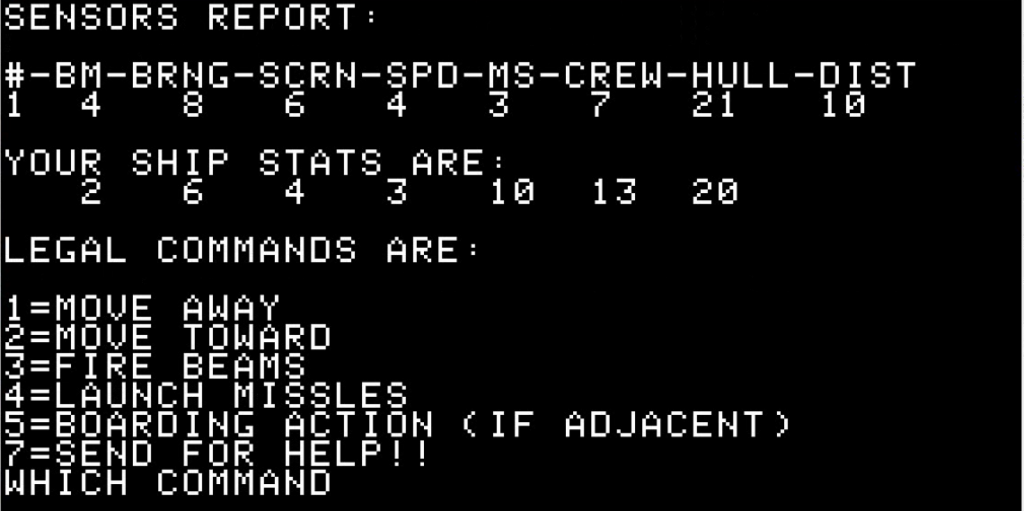
The combat system in Star Explorer is quick and streamlined. Each ship has a certain number of beams (BM) and missiles (MS). The missiles have infinite range, but the beams have a limited range (BRNG). Damage is first absorbed by the screens (SCRN) and then reaches the hull…
… or you can quite simply close the distance as quickly as possible and board the enemy ship, so your crew fight their crew. The Constellation has 3 actions per turn, including using the sensors, whereas pirates always use one missile (if any), then their beams (if within range) and then close the distance (DIST) by their speed (SPD). I wait one turn so their distance becomes 6, then use my 3 actions to move twice and board them. The ship is easily captured, netting me quite a revenue.
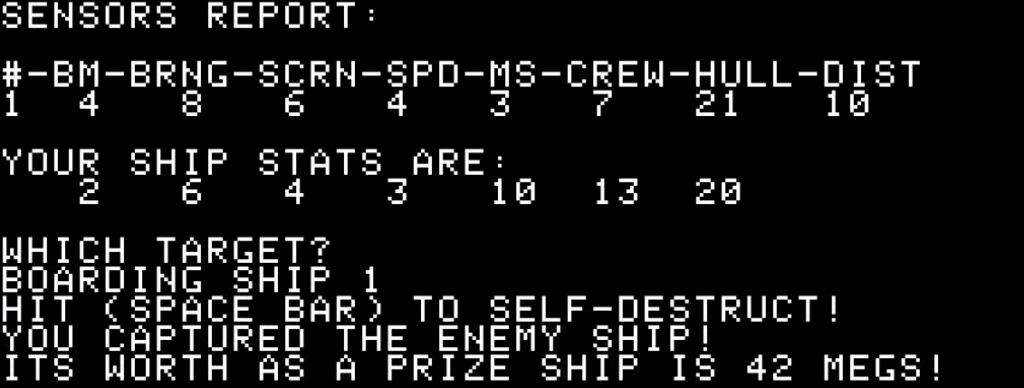
After this combat, I find a small inhabited planet:

I jump to system 8, 8 and find 5 stars.

After some exploration and eliminating some isolated pirates, I am attacked by a whole group!
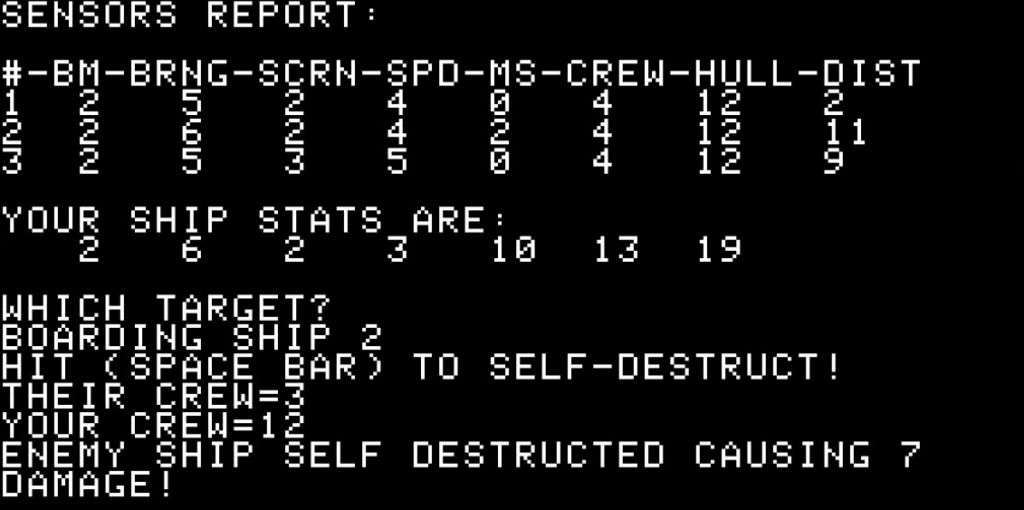
I use my missiles to destroy one, and then board the 2 others, capturing them!
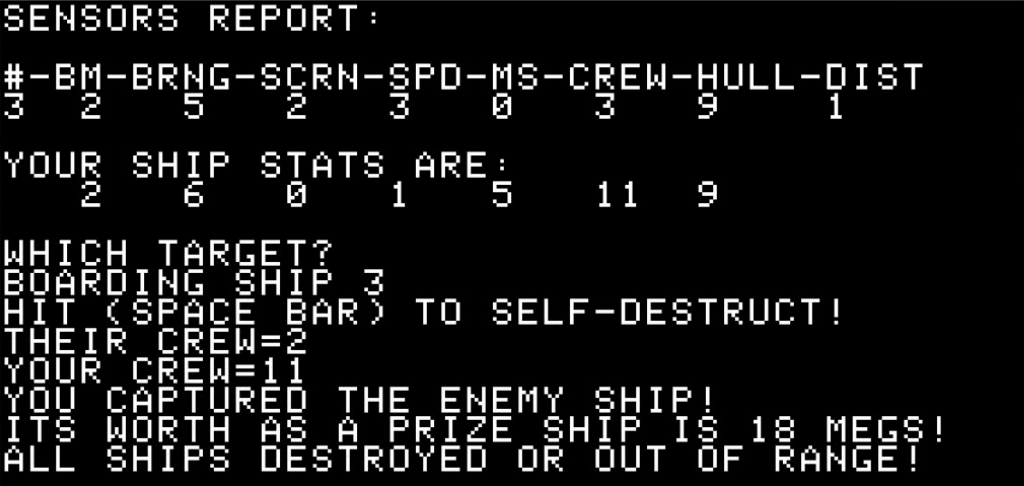
My hull is down to 9, my boarding crew to 11, and my speed to only 1 (if I had a repair team, I could bring it back to 3 – but I don’t). Time to head home:
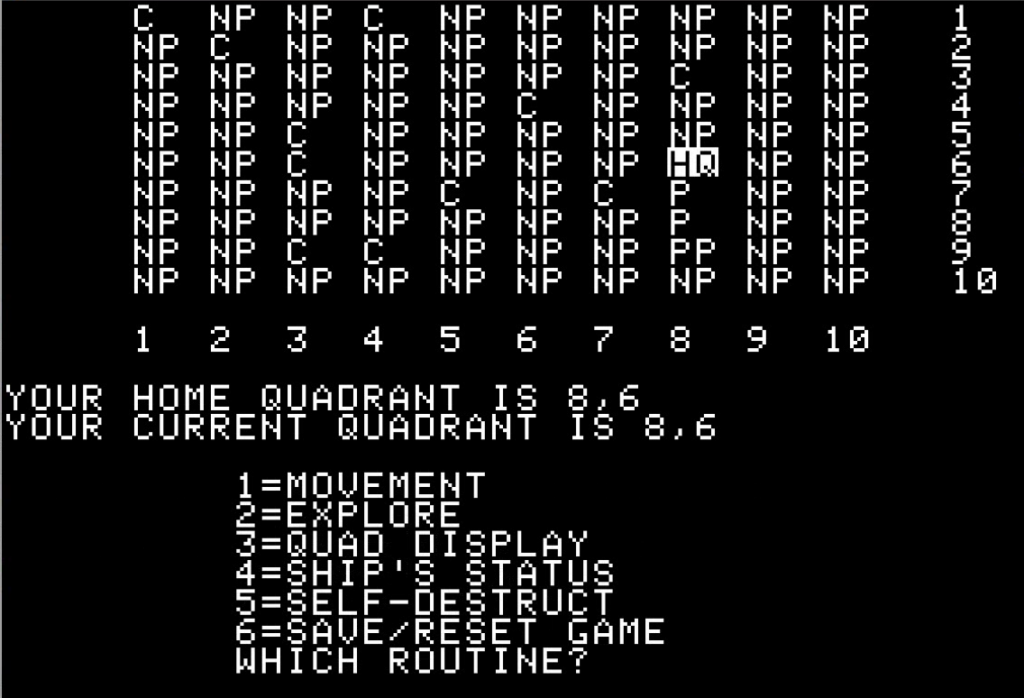
I receive the P&L of that first mission, and it is in the black!
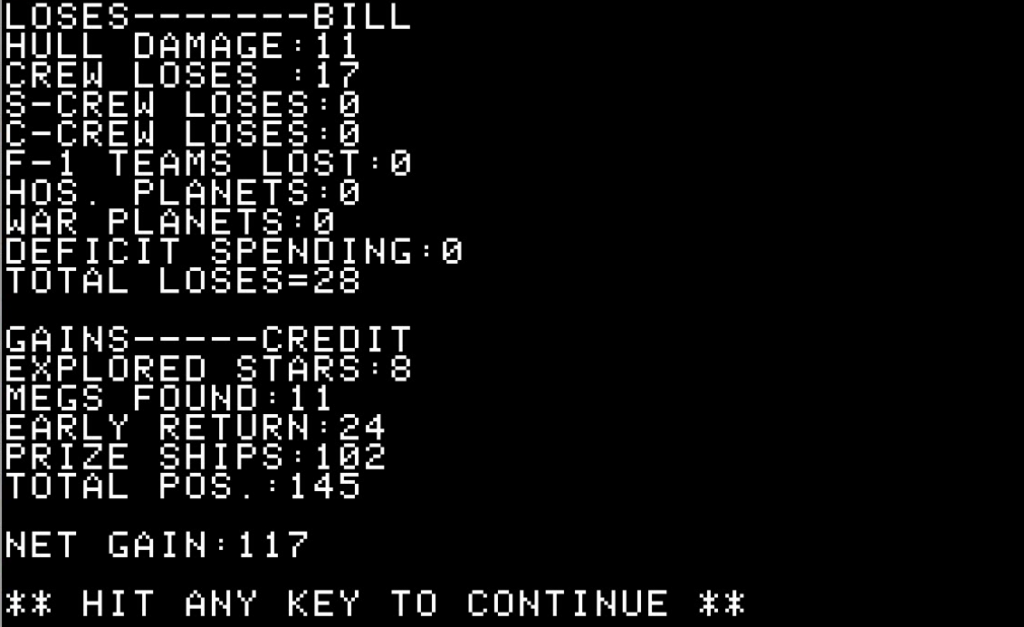
Second mission: The bolt of system 8,5
Before launching my second mission, I get to experiment with a neat feature: ship upgrade!
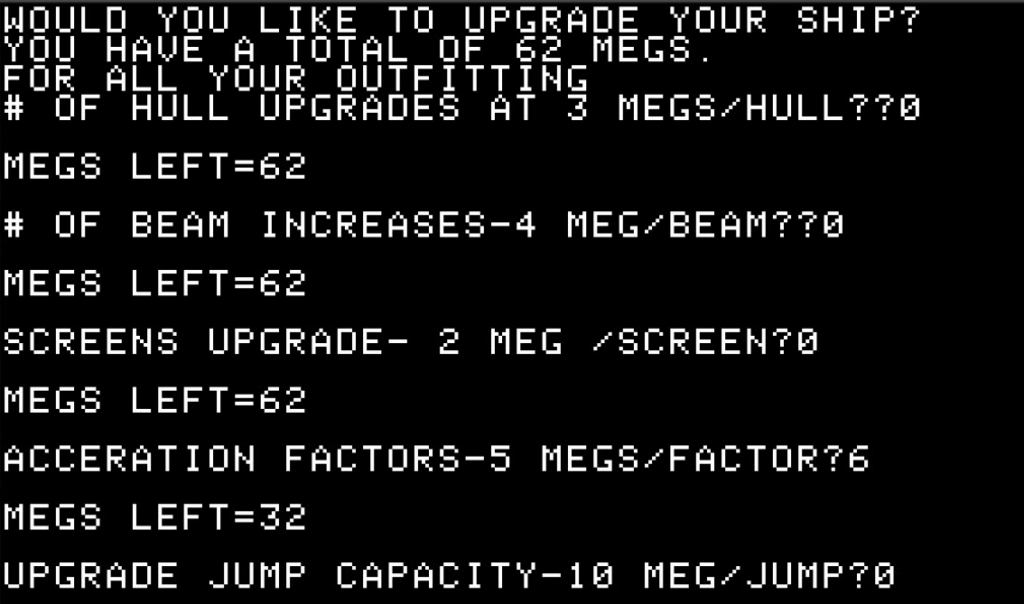
I hesitate between giving myself an ungodly number of beams or an ungodly speed, and I choose the latter. With a speed of 9, I can board any ship with less crew than mine and escape the rest. I use the rest of the money to refurbish the Constellation more or less like in the first mission.
This immediately proves useful as I am engaged by pirates in system 8,5. I destroy one ship with missiles, then close the range and board them. The pirates resist long enough for my boarding attempt to be interrupted… and then they foolishly decide to try to board the Constellation. Their “no, WE are boarding you” moment goes poorly, and both enemy ships are captured!
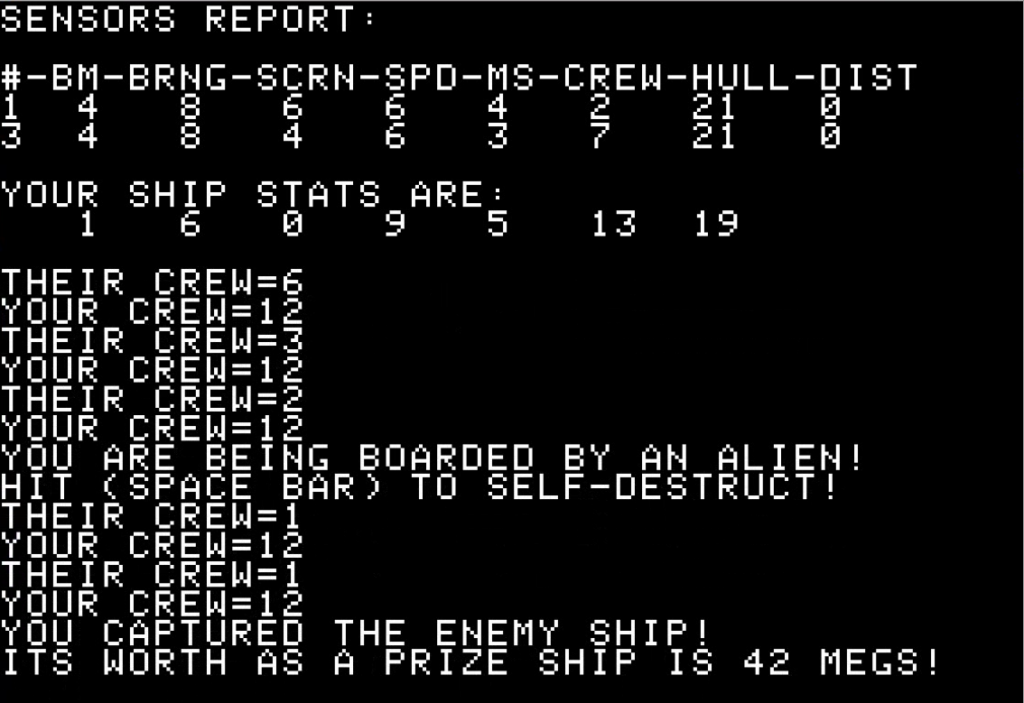
System 8, 5 has only one star, and its planet is populated by a particularly primitive race of rodents. After a mishap that claimed the life of Security Officer Peter, we find an understanding with the rats. There are 20 megs of value in the system, and I tell the rats I want to share it brotherly. They agree and give me 15 megs.
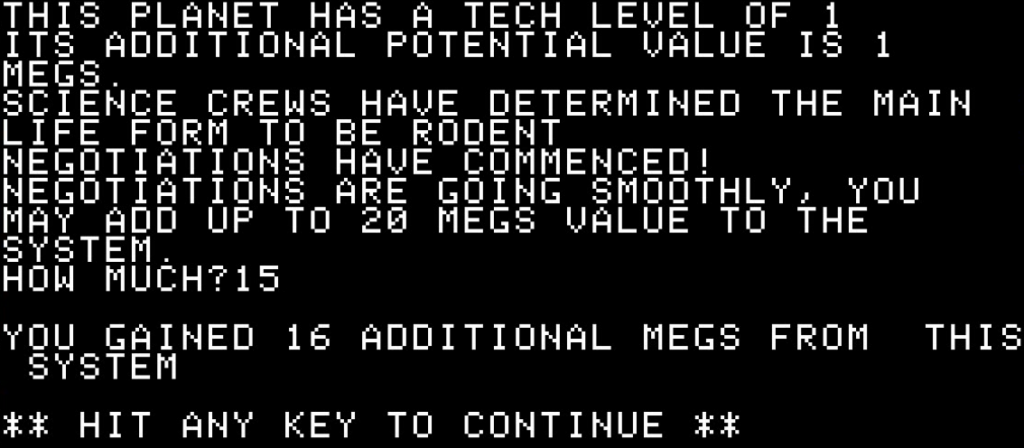
I then move to 8,4, a system with 5 planets. The first one is populated by bad, bad dogs who kill ensign Riley and then blackmail me, which of course I accept, because I have no spine.
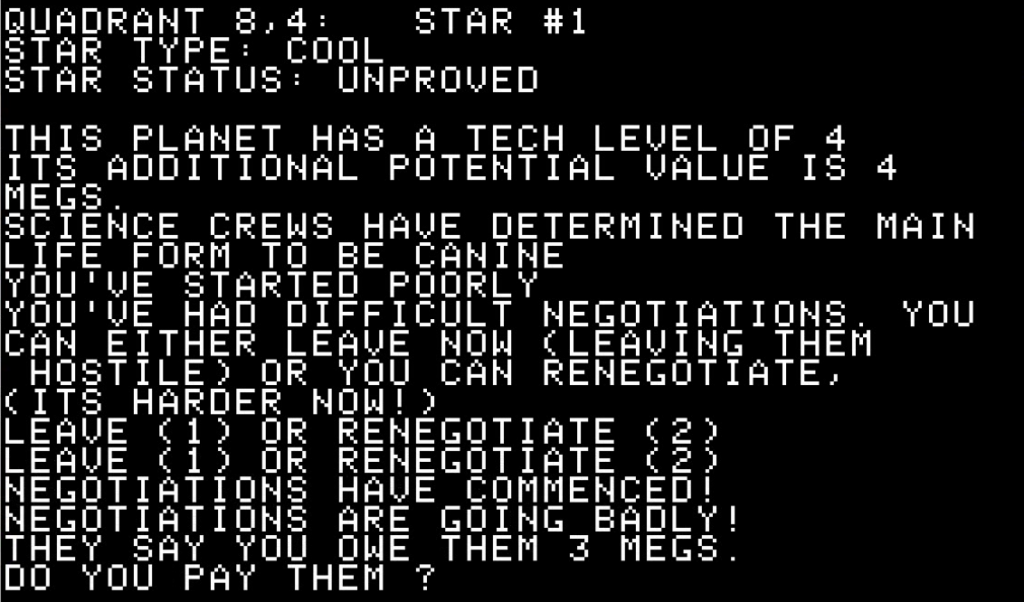
As for the second one, it is populated by bears who attack me!
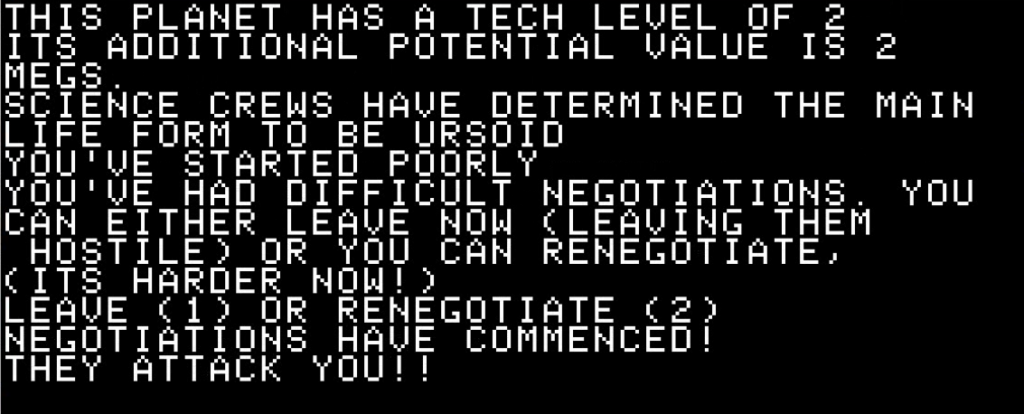
The survey crews must now flee the planet and reach the ship (you can’t “conquer” a planet because of that stupid Prime Directive). In this case, the situation starts desperate given the distance between my first-in team (F1) and the Constellation!
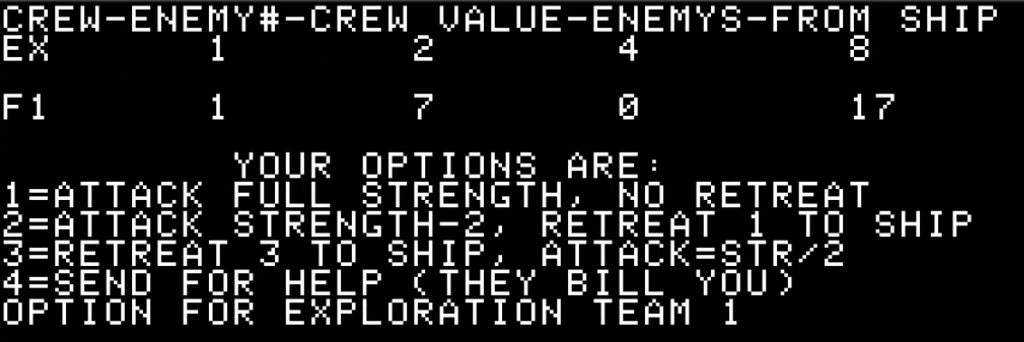
Each movement toward the ship costs strength, so neither team will make it. Ultimately, I request help from the Federation. It costs me 20, and my team is beamed up.

I explore the remaining stars with the usual native contacts and pirate attacks (I escape one particularly dangerous group thanks to my superior speed), and return home.
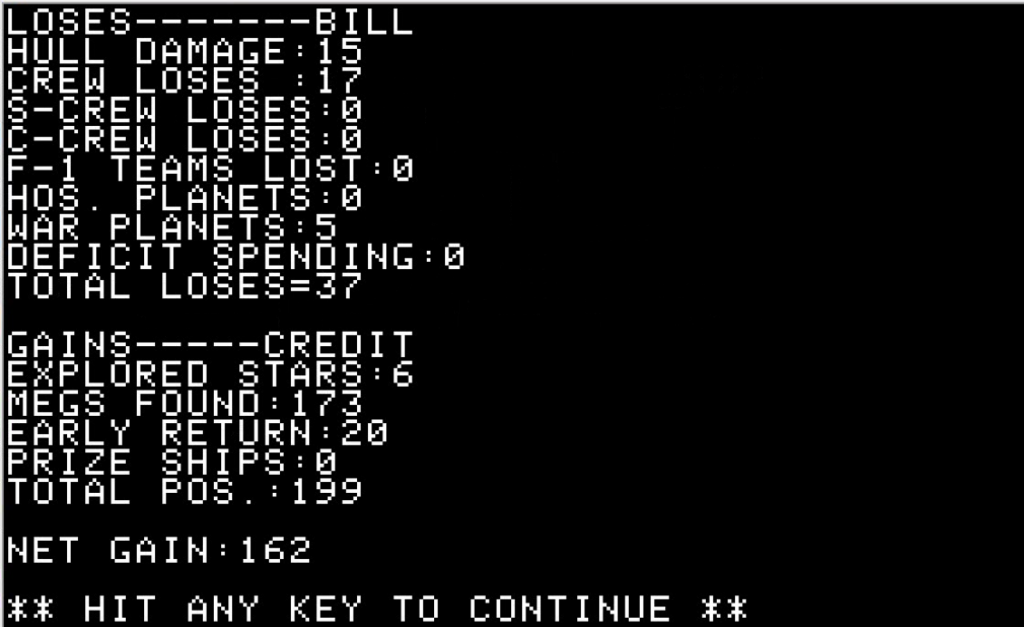
Third mission: The Final Voyage
As I prepare my third voyage, I was surprised to discover that whatever racey tech I bought for the Constellation in my second mission is gone. I need to buy it again. Frustrating, but as I am richer now than I was then, I can buy the speed booster to a repair crew and as many men as I can cram onboard. That done, I head towards system 7,6!
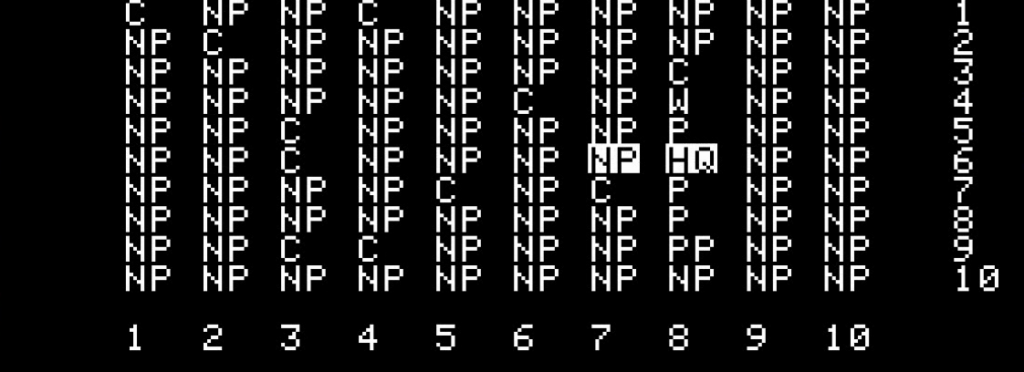
I find the usual planets, guarded by the usual pirates. The first group is so powerful that I have to escape (but not before being hit by a volley of torpedoes which dinged my hull). The second group, however, has skeletal crews. That’s prize money!
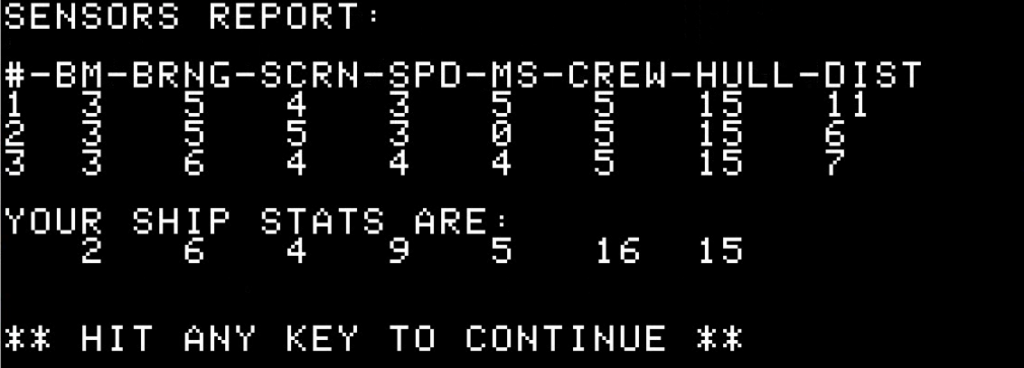
Well, I am wrong! Just as I assault the closest ship, the pirates sabotage their ship, blowing her… and the Constellation as well!
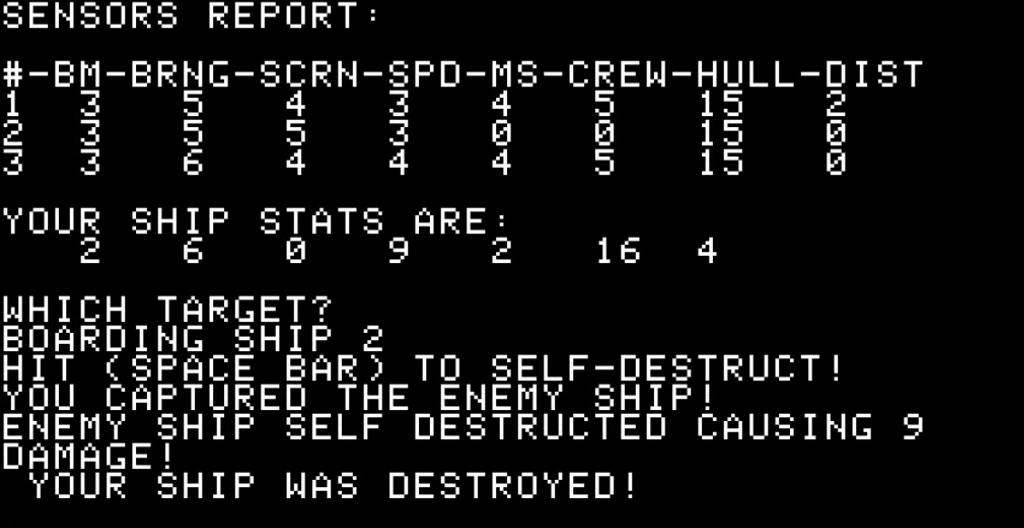
So that’s why captains can’t just board every ship they meet in space?
This is the end, which is just as well, I had little more to show you in this game.
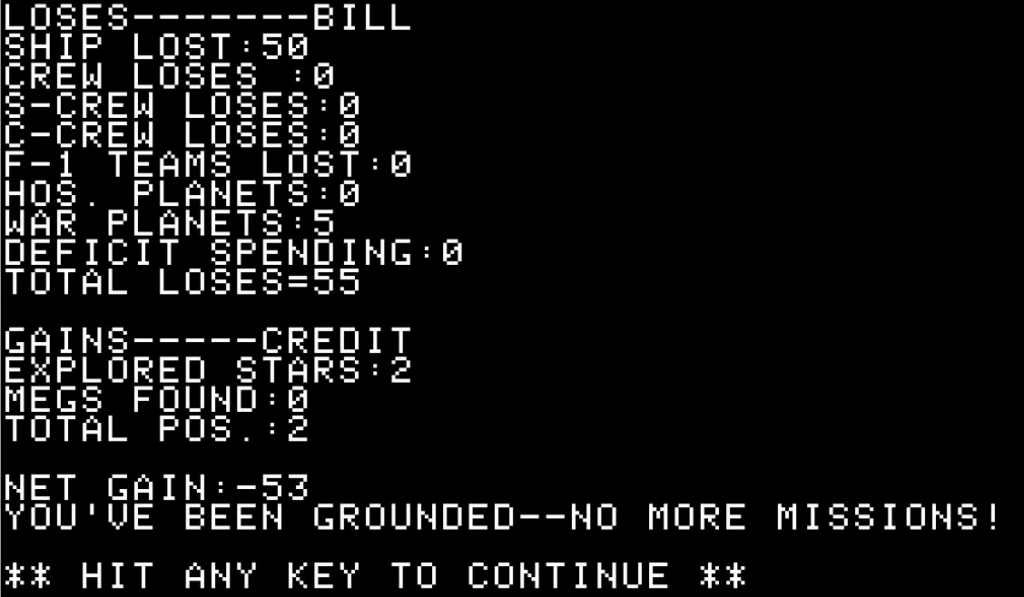
Ratings & Reviews
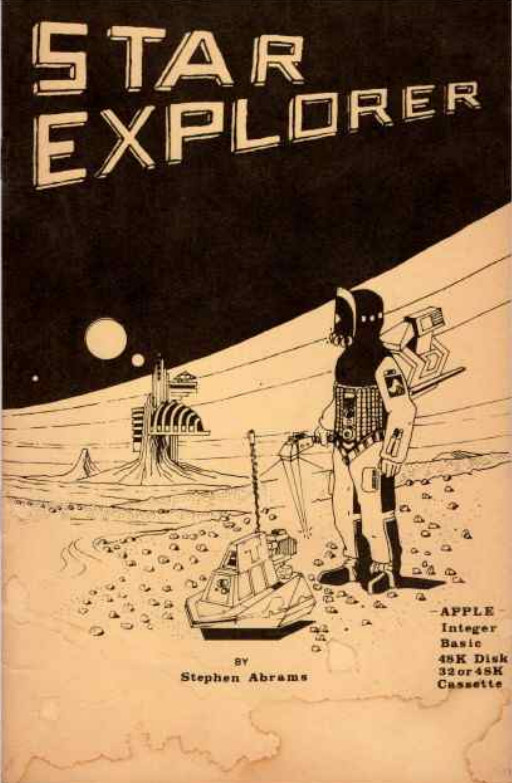
Star Explorer by Stephen Abrams, published by Abrams & Everson (aka Midkemia Press),
First release: 1980 on Apple II
Genre: Exploration
Average duration of a campaign : 20 minutes by expedition
Total time played: 2 hours
Complexity: Low (1/5)
Rating: Totally obsolete
Ranking at the time of review: 100/145
In 1975, Stephen Abrams, Joe Everson and Conan Lamot were three students at University of California – San Diego (UCSD) and regulars of the Triton Wargaming Club. One day, Lamot introduced the two others to a new game he had purchased in Los Angeles: Dungeons & Dragons (D&D). This was back when D&D was an expansion on the miniatures wargame Chainmail, which Lamot did not have, but he had copied all the relevant rules and information in a guide he called “The Tome of Mid-Kimia” – Lamot just liked how that sounded. D&D immediately conquered not only the three friends, but the whole Triton Wargaming Club.
Alas, the Triton Wargaming Club favoured the kind of power gaming that forces game masters to rely on the Deities and Demigods book as their monster manual. Instead of joining munchkinesque adventurer parties, the trio went their own way, with Everson and Abrams soon (1976) designing a ruleset and then a world which, while still “fantasy”, was also more grounded in medieval realism: Midkemia. The new RPG proved popular after all, and the Everson/Abrams duo reckoned that having done the legwork, they could just run the extra mile and start a role-playing game company: the creatively-named Abrams & Everson, est. 1979.
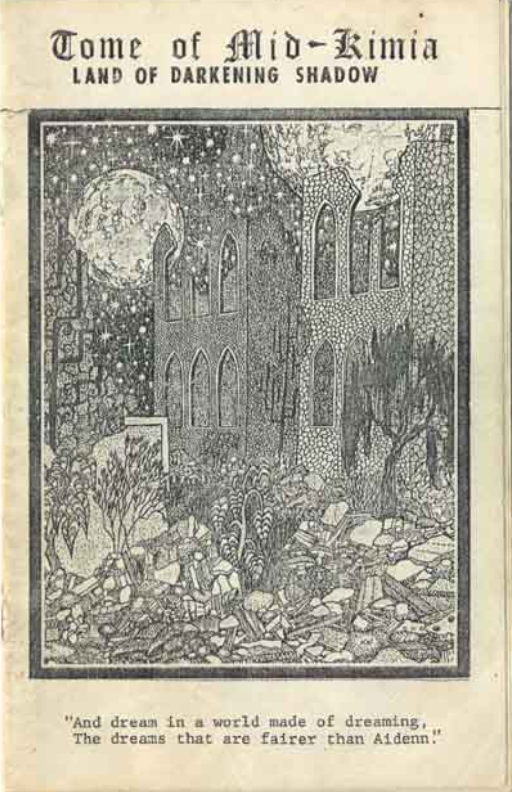
The first product of Abrams & Everson was the popular Cities, a rule-agnostic gamebook for running urban campaigns. It received four editions and unanimous praise, including from far-away UK (White Dwarf, Games International) and France (Casus Belli). Shortly after City, Abrams & Everson became Midkemia Press (1980) and enlarged the team, adding in particular to the roster Raymond Feist, a veteran of the 1976 campaigns who would, only a couple of years down the line, use the world of Midkemia as a background for his famous Riftwar Cycle. Under its new name, Midkemia Press published 8 more titles, until 1983… and then it hibernated. It would occasionally awaken, not least of course with the computer game Betrayal at Krondor in 1993, but that’s way beyond the scope of this article.
For now, let’s go back in time a bit. Abrams had been an early Apple II adopter, buying his first one in 1977 or early 1978 (he remembers the serial number as being around 1250). He almost immediately taught himself how to code, and by the end of 1978 he was working as a software engineer for the NCR corporation. Of course, he used his new skill to code all sorts of games for the consumption of his group of friends. However, between his new job and Midkemia Press he had little time to turn his creations into publishable games, except for one game: Star Explorer, a close but unofficial port of TSR’s Star Probe.
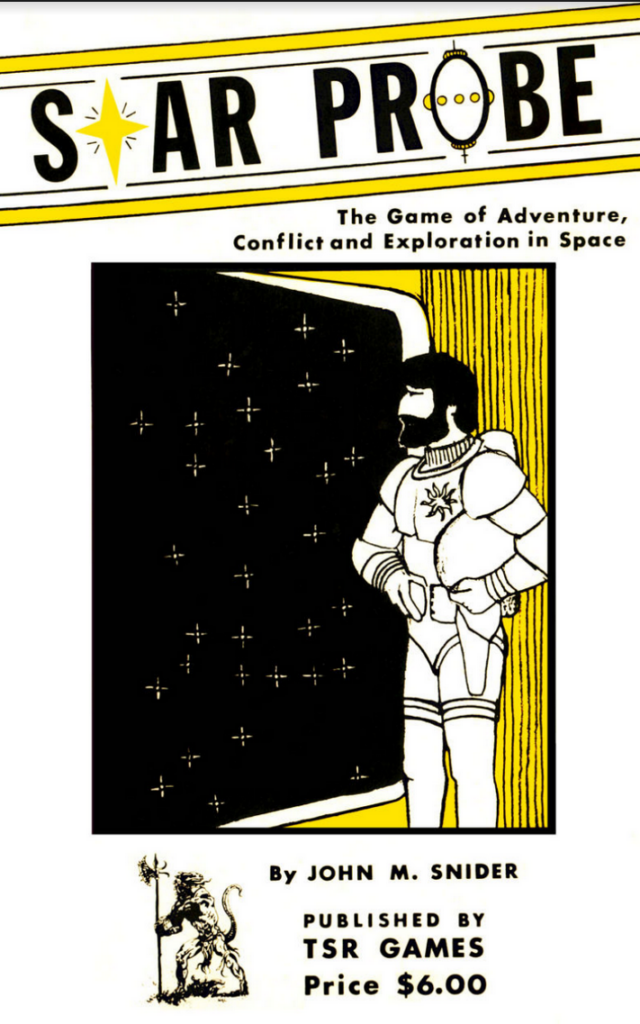
John Snider’s Star Probe, released in 1975, comes from a transient moment in the life of TSR. This was between Gen Con VII in August 1974 when Gygax et alii knew D&D was successful, and late 1976 when they knew they had a genre-creating banger, Gygax was looking for content that did not have to be D&D or RPG-related. Snider had a powerful ally: he was one of the original players of D&D co-designer David Arneson, back when the latter was running the Blackmoor (pre-D&D) RPG table in Minneapolis, and presumably with Arneson’s support he managed to convince TSR to publish his game. The decision made sense however, nerds across America were yearning for more Star Trek content, and the space genre was at the height of its popularity. Gygax and Snider envisioned a trilogy: Star Probe about exploration, Star Empires (1977) about empire-management, and a third title we’ll never know about because the trilogy was cancelled after Star Empires.
Star Probe, just like Stellar Conquest, is a game that screamed “please port me on a computer“: 2000 planets, a 3-dimensional star map, undecipherable charts, random numbers to hide and reveal several times by turn, way too many values to keep track of after each die, each chart and each matrix – and that’s before taking into account combat management.
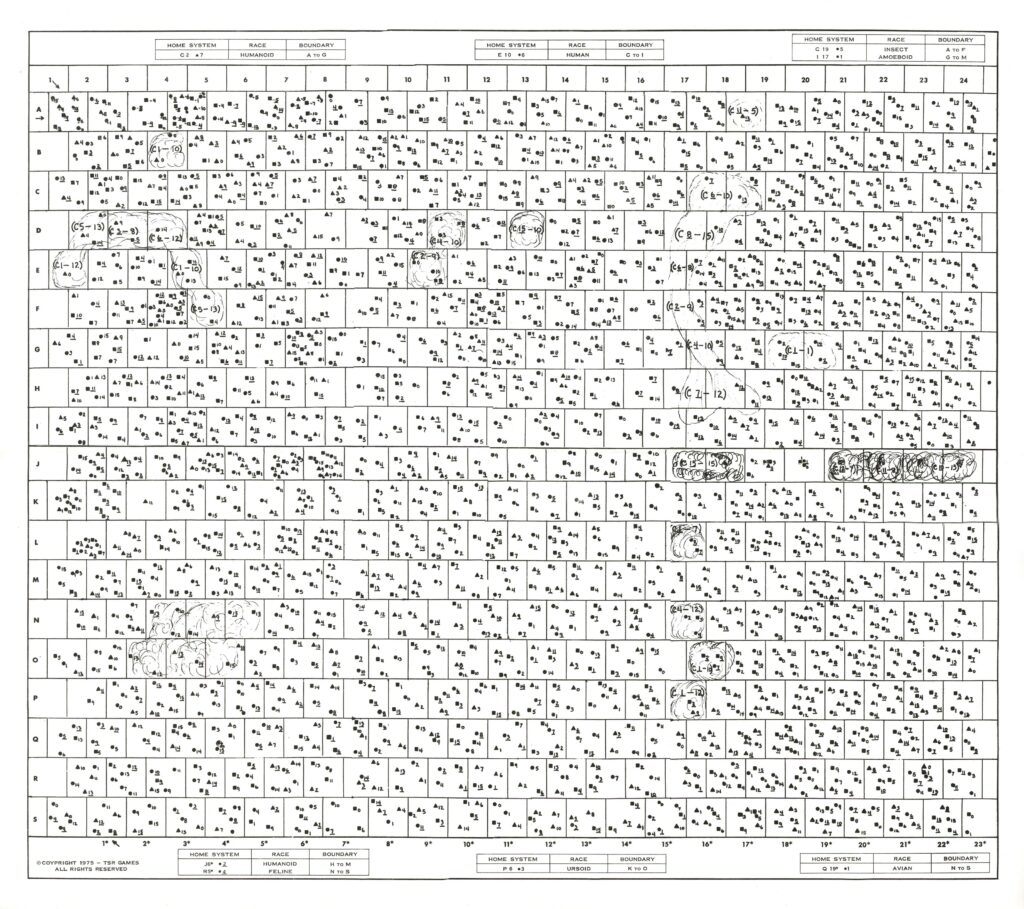
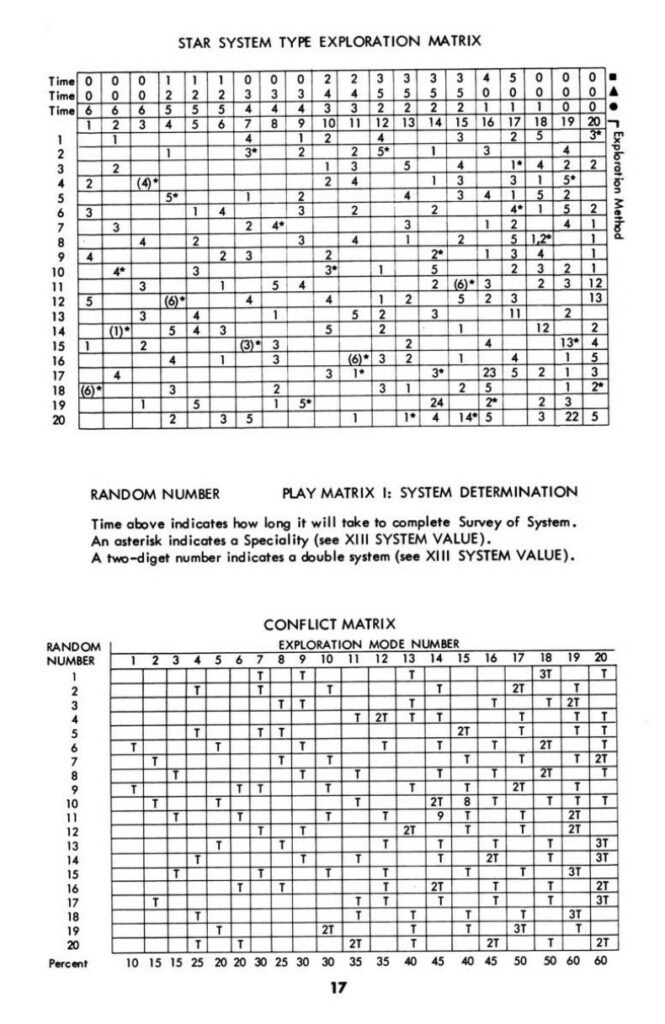
I suppose that Abrams was playing everything he received from TSR, and the scope of Star Probe must have inflamed his imagination. For the furnishing of the ship and the exploration properly said, Star Explorer mimics Star Probe very closely, with only minor simplification here and there – even the prices of ship equipment are the same. For combat, however, Star Explorer massively simplified Star Probe, which is probably for the better as the latter included Newtonian physics and directional attacks!
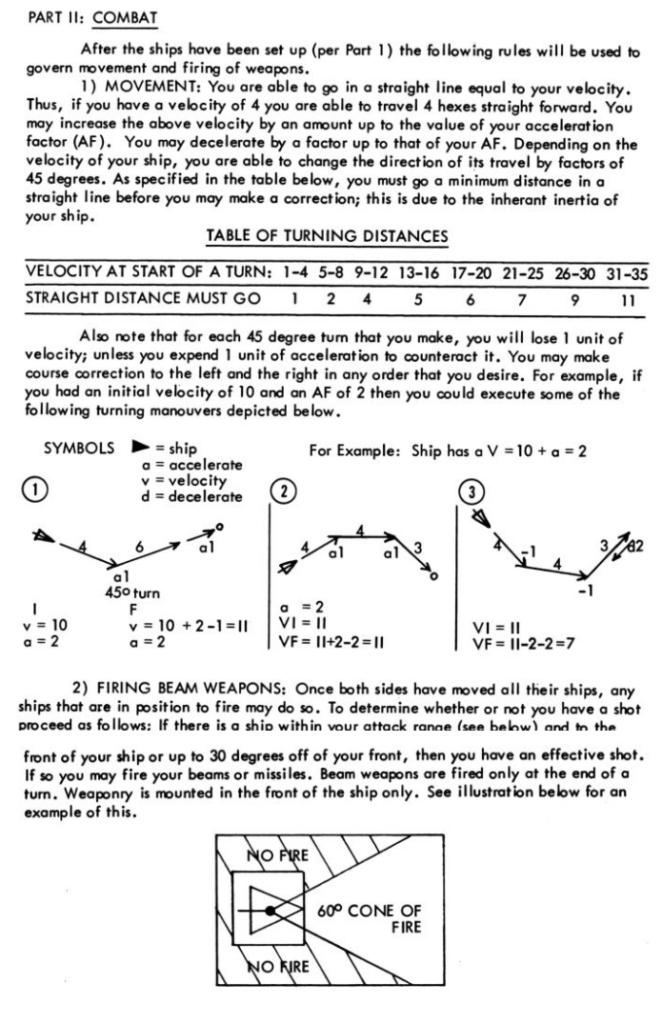
Abrams tried to sell Star Explorer in conventions and through ads in fanzines, with extremely limited success; as I said he sold fewer than 200. TSR’s reputation as being litigation-happy probably discouraged him from finding a publisher with more reach – not that there were many of these in 1980 – and Star Explorer soon faded into obscurity.
Traits – As for the game itself, there is little to add that I did not showcase. There are few available results when exploring: pirates, some resources or a race with which you can negotiate, so the excitement of exploration quickly wanes off. As for the battles, the ones in space are too simple, and the ones on land (the “escapes”) are stale as their result is obvious from the beginning.
I reckon that what’s missing from Star Explorer to turn into a primitive FTL: Faster Than Light is a chance to find items that you could use immediately to upgrade your ship. This would have made exploration exciting for much longer and created more varied tactical situations in space combat. I know that, because I had some fun testing different combinations for my ship after the success of the first mission which I found consistently boring; this made not keeping your upgrades after your second return even more frustrating.
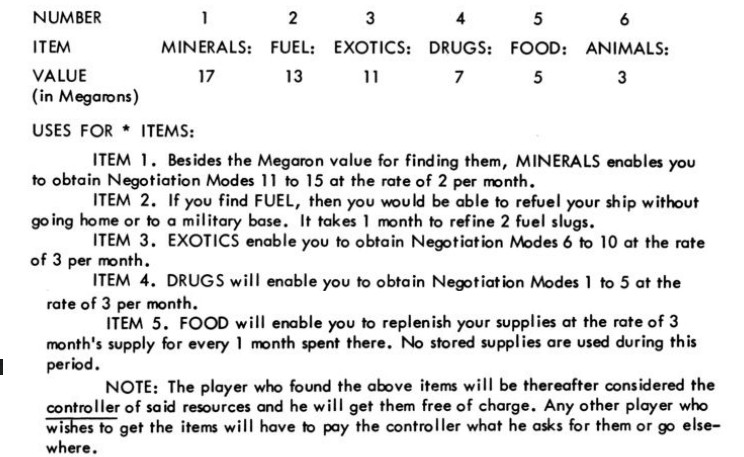
Did I make interesting decisions? A bit. Mostly when furnishing my ship (including after my first return), else it’s mostly stop or encore.
Final Rating: Totally obsolete. Finding Star Explorer was more important for the history of Midkemia Press than for the one of gaming, though it’s still rewarding to remove a name from the “lost media” list.
Aftermath
Star Explorer was almost a one-off thing from Midkemia Press, as they only ever released another computer game (The Cube by Patricia Shanahan) but it had an unexpected legacy. At a conference where he was showcasing his rulebooks and Star Explorer, Abrams met SPI’s Redmond Simonsen. They talked computer and video games, and Simonsen asked Abrams whether he wanted to work for them as a consultant and a point of contact on the West Coast, as SPI was headquarted in New York. Abrams accepted. It had its perks, including seeing an early showing of Star Trek: The Wrath of Khan – probably an emotional moment for the kind of person who ports a game like Star Probe on computer. But more importantly, Abrams ported Simonsen’s The Wreck of the BSM Pandora, one of the favourites of this blog; he is the mysterious Stephen Abrams of which I had said “I could not find any information on Abrams.” A loose thread has been tied up.
This article would not have been possible without a lot of different people – I want to thank them:
– Jason Dyer from creating his blog in the first place. No blog, no comment, no Star Explorer,
– f15Sim from Renga-in-Blue for digitalizing and uploading his disks,
– Gus Brasil from Renga-in-Blue for finding the games Jason was looking for and starting the Great Rummage,
– Porkbelly for finding Star Explorer in the data repository,
– LanHawk fur turning Star Explorer into a readable .dsk format,
– Stephen Abrams for answering my many questions.
3 Comments
I have never played FTL but reading your report reminded me strongly of Master of Orion. I was surprised to read the final verdict as the gameplay seemed interesting, but probably I projected my MoO memories onto your description.
The cover illustration of “The Tome of Mid-Kimia” is wonderful. Is it by Lamot himself, an artist he hired or just ripped from some TSR product?
As I understand, all arts were done in-house by some of the members of the club. Abrams gives a few names: Mary Coman, Richard Spahl and Ray Feist himself. I think it was too early to rip-off TSR, which did not have outstanding artists yet.
Lamot’s role was seminal when he brought the (first) tome and imagined name “Midkemia”, but he played no significant role in the creation of the Midkemia universe itself, and drifted away from the group immediately after graduating.
Awesome coverage and game. I see lots of Star Fleet II : Kremlin Commander in this, but nothing that couldn’t have been developed without this as inspiration. Love the coverage!